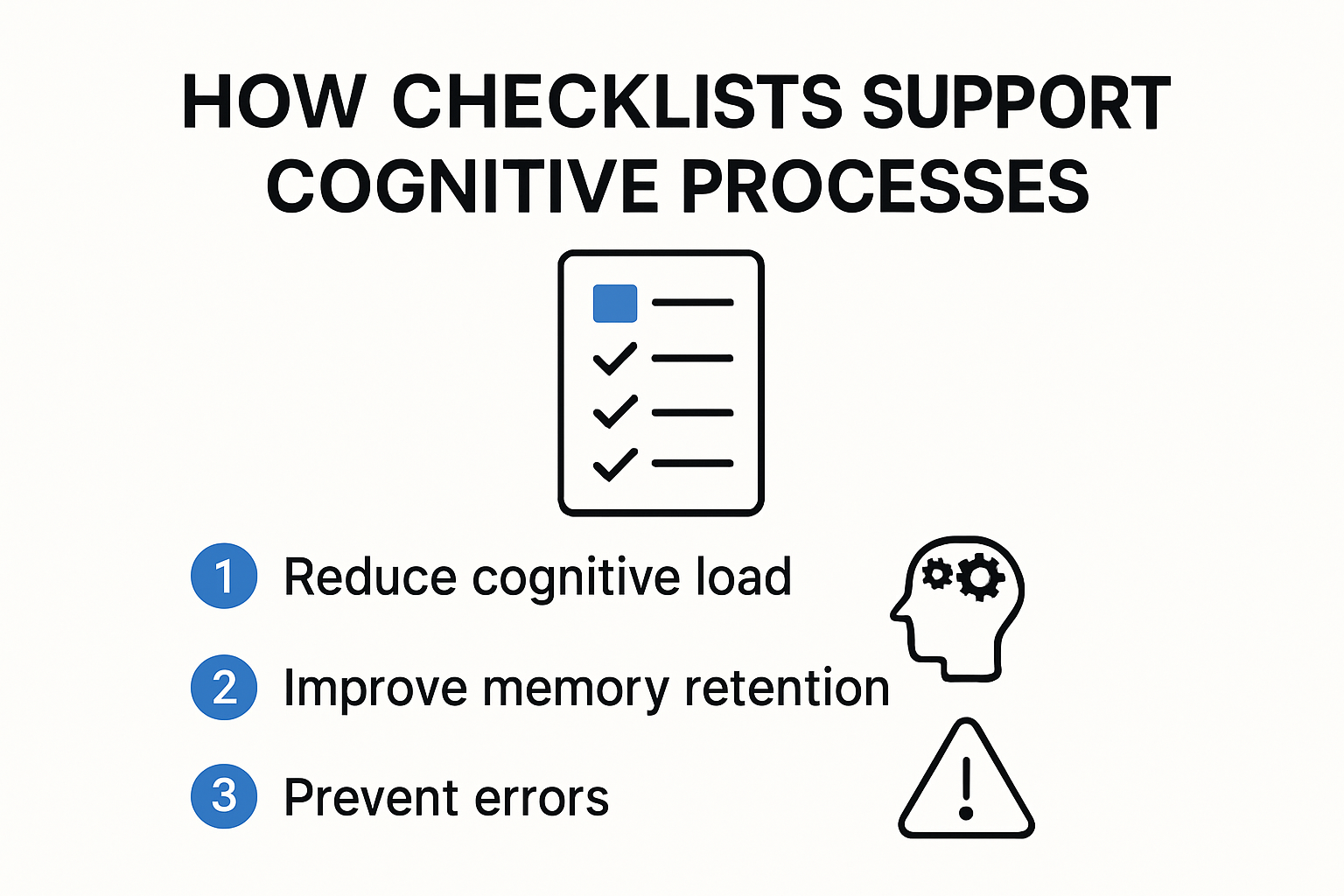Checklists have powered everything from hospital surgeries to airline takeoffs, and their impact is backed by numbers. Structured checklists can reduce mistakes by up to 40 percent in complex settings. Sounds like a no-brainer for efficiency, right? Here’s the twist. The real secret to next-level results is not just using a checklist, but mastering how you design, roll out, and reinvent it for your team. This changes everything you thought you knew about productivity tools.
Table of Contents
- Understanding The Power Of Checklists
- Essential Steps For Effective Checklist Creation
- Best Practices For Teams And Businesses
- Digital Tools To Streamline Checklist Management
Quick Summary
| Takeaway | Explanation |
|---|---|
| Checklists Enhance Performance | Structured checklists significantly improve performance and reduce errors by providing a reliable framework for executing complex tasks. |
| Design Is Crucial | Effective checklists require intentional design, taking into account user expertise and environmental context to ensure clarity and adaptability. |
| Iterative Improvement | Checklist creation should be viewed as an iterative process, with regular evaluations and updates based on team feedback and real-world usage. |
| Collaboration Is Key | Successful checklists thrive in collaborative environments where team members can contribute feedback and adapt the tools to evolving organizational needs. |
| Leverage Digital Tools | Implementing digital checklist management enhances productivity through automation, real-time collaboration, and comprehensive analytics for continuous improvement. |
Understanding the Power of Checklists
Checklists are powerful tools that transform complex tasks into manageable, systematic processes. Far from being simple lists of actions, they represent strategic frameworks that guide professionals through intricate workflows with precision and reliability.
The Cognitive Science Behind Checklists
At their core, checklists leverage fundamental principles of human cognitive processing. Research from the Agency for Healthcare Research and Quality reveals that checklists are particularly effective in complex scenarios, especially for individuals with varying levels of experience. They serve as external memory aids, reducing cognitive load and minimizing the potential for human error.
By breaking down complicated procedures into clear, sequential steps, checklists help professionals maintain focus and systematically address each critical component of a task. This approach is especially crucial in high-stakes environments where precision can mean the difference between success and failure.

Performance Enhancement and Error Reduction
Empirical studies in medical education demonstrate that structured checklists significantly enhance performance across various domains. They act as cognitive scaffolding, providing a reliable framework that guides individuals through complex processes while ensuring no critical steps are overlooked.
Key performance benefits include:
- Consistency: Ensures uniform execution of tasks across different team members
- Accountability: Creates clear documentation of completed actions
- Risk Mitigation: Systematically reduces potential errors through structured guidance
To help visualize these key benefits, the table below summarizes the main advantages of using structured checklists, as described in this section:
| Benefit | Description |
|---|---|
| Consistency | Ensures uniform execution of tasks across different team members |
| Accountability | Creates clear documentation of completed actions |
| Risk Mitigation | Systematically reduces potential errors through structured guidance |
Designing Effective Checklists
Research published in scientific journals emphasizes that checklist design must be intentional and tailored to specific contexts. The most effective checklists consider user expertise, task complexity, and the specific environment in which they will be implemented.
Successful checklist creation involves understanding the nuanced requirements of a specific workflow. This means developing clear, concise instructions that are both comprehensive and adaptable. The goal is not to create a rigid set of rules but a flexible guide that supports professional judgment and adapts to varying scenarios.
Professionals across industries from healthcare to aviation have long recognized the transformative power of well-designed checklists. They represent more than just a tool - they are a strategic approach to managing complexity, reducing cognitive burden, and ensuring consistent, high-quality performance in an increasingly complex world.
As leaders and professionals continue to seek methods for improving organizational efficiency, checklists emerge as a simple yet profound solution to managing intricate workflows with confidence and precision.
Essential Steps for Effective Checklist Creation
Creating an effective checklist requires strategic planning and thoughtful design. While seemingly simple, these tools demand precision and careful consideration to truly enhance workflow and performance.
Understanding Checklist Architecture
Productivity experts from W5 Coaching emphasize that successful checklists are not just random collections of tasks, but carefully structured guides that facilitate systematic execution. The architectural foundation of a robust checklist involves several critical components.
Primary considerations include defining clear objectives, identifying critical steps, and ensuring logical progression. Professionals must approach checklist creation with the same rigor applied to complex project management strategies. This means meticulously mapping out each stage of a process and understanding potential points of failure or complexity.
Strategic Development Techniques
Effective checklist development requires a multi-dimensional approach. Research indicates several key strategies for creating impactful tools:
- Collaborate with Practitioners: Involve team members who directly perform the tasks to ensure comprehensive and practical documentation
- Maintain Brevity: Aim for concise lists that fit on a single page, typically containing five to nine critical items
- Use Clear Language: Craft instructions using simple, familiar terminology that all team members can easily understand
The goal is not to create an exhaustive document but a focused, actionable guide that supports efficient workflow and reduces potential errors.
The table below summarizes essential strategies for effective checklist development, as outlined in this section:
| Strategy | Purpose |
|---|---|
| Collaborate with Practitioners | Ensure practical documentation by involving real task performers |
| Maintain Brevity | Keep the checklist concise and focused (typically 5-9 items) |
| Use Clear Language | Make instructions simple and easily understood by all team members |
Refinement and Implementation

Checklist creation is an iterative process that requires continuous evaluation and improvement. After initial development, teams should pilot the checklist in real-world scenarios, gathering feedback and making necessary adjustments.
Key implementation strategies include:
- Conduct pilot tests in controlled environments
- Gather feedback from multiple team members
- Regularly review and update the checklist based on practical experiences
- Train team members on proper checklist utilization
Successful checklists transcend mere task documentation. They represent a systematic approach to knowledge management, performance optimization, and error reduction. By treating checklist creation as a strategic initiative rather than an administrative task, organizations can transform these simple tools into powerful performance enhancement mechanisms.
Leaders who invest time in developing precise, user-friendly checklists create environments of consistency, accountability, and continuous improvement. The art of checklist creation lies not just in listing tasks but in understanding the nuanced dynamics of human performance and organizational workflow.
Best Practices for Teams and Businesses
Implementing checklists effectively requires a strategic approach that goes beyond simple task listing. For teams and businesses, checklists become powerful tools for standardization, communication, and performance optimization.
Creating Collaborative Checklist Environments
Successful checklist implementation starts with fostering a culture of collaboration and continuous improvement. Organizational management research highlights that effective checklists are not top-down directives but collaborative frameworks that engage team members at all levels.
Key considerations include creating an environment where team members feel empowered to provide feedback, suggest improvements, and openly discuss checklist effectiveness. This approach transforms checklists from rigid instructions into dynamic tools that evolve with organizational needs.
Communication and Standardization Strategies
Effective checklists serve multiple organizational purposes beyond task completion:
- Process Standardization: Ensure consistent performance across different team members and departments
- Knowledge Transfer: Create clear documentation of critical workflow steps
- Performance Tracking: Provide measurable indicators of task completion and quality
Businesses must design checklists that are clear, concise, and adaptable. This means using simple language, avoiding unnecessary complexity, and creating templates that can be easily customized for different scenarios.
Continuous Improvement and Adaptation
Checklists are not static documents but living tools that require regular review and refinement. Organizations should establish systematic processes for:
- Regular checklist audits
- Gathering team feedback
- Identifying potential improvements
- Updating documentation based on practical insights
By treating checklists as dynamic resources, businesses can create flexible systems that respond to changing operational requirements. This approach ensures that checklist tools remain relevant, effective, and aligned with organizational goals.
Leaders who view checklists as strategic assets rather than bureaucratic requirements can transform these simple tools into powerful mechanisms for enhancing organizational efficiency, reducing errors, and promoting a culture of systematic excellence.
Ultimately, the most successful checklists are those that balance structure with flexibility, providing clear guidance while allowing room for professional judgment and innovative problem-solving. They become more than just lists - they represent a sophisticated approach to managing complexity in modern business environments.
Digital Tools to Streamline Checklist Management
The digital revolution has transformed checklist management from traditional paper-based systems to sophisticated, intelligent platforms that enhance productivity and collaboration across organizations.
Technological Capabilities in Checklist Management
Research from Bantham Technologies demonstrates that digital checklists offer substantial advantages over traditional methods. These advanced tools automate repetitive tasks, reduce paperwork, and create unprecedented levels of transparency in workflow management.
Modern digital checklist platforms integrate multiple functionalities that go beyond simple task tracking. They provide real-time collaboration features, automated notifications, progress tracking, and comprehensive analytics that help teams understand their performance metrics and identify potential improvement areas.
Integration and Collaboration Technologies
Cutting-edge research on task management technologies reveals innovative approaches to streamlining team collaborations. Emerging solutions now incorporate chatbot-mediated task creation, assignment, and tracking directly within primary communication channels.
Key technological features include:
- Automated Workflow Routing: Automatically direct tasks to appropriate team members
- Real-time Progress Tracking: Provide instant visibility into task completion status
- Cross-platform Compatibility: Enable seamless access across multiple devices and operating systems
Strategic Implementation and Governance
The OECD’s E-Leaders Handbook emphasizes the critical importance of developing robust governance frameworks for digital transformation. Organizations must approach digital checklist implementation strategically, considering factors such as:
- User experience and interface design
- Data security and privacy protocols
- Scalability and future technological adaptability
- Integration with existing organizational systems
Successful digital checklist management goes beyond mere technological implementation. It requires a holistic approach that considers organizational culture, team dynamics, and specific workflow requirements.
Leaders must view digital checklist tools not as standalone solutions but as integral components of a broader digital transformation strategy. By selecting platforms that offer flexibility, comprehensive features, and intuitive design, organizations can create powerful systems that enhance productivity, reduce errors, and foster a culture of continuous improvement.
The future of checklist management lies in intelligent, adaptive digital platforms that can learn from organizational patterns, predict potential bottlenecks, and provide proactive recommendations for workflow optimization. As technology continues to evolve, these tools will become increasingly sophisticated, transforming how teams collaborate and execute complex tasks.
Frequently Asked Questions
What are the benefits of using checklists in a professional setting?
Checklists enhance performance by providing a structured framework that reduces errors, ensures consistency, and increases accountability across tasks.
How should I design an effective checklist?
An effective checklist should be intentionally designed with clear, concise language and structured logically to adapt to user expertise and task complexity.
What steps should I follow to create a checklist?
To create a checklist, start by understanding its architecture, develop it strategically with input from practitioners, and continuously refine it based on real-world testing and feedback.
How can digital tools improve checklist management?
Digital tools streamline checklist management by automating tasks, enabling real-time collaboration, and providing analytics for continuous performance improvement.
Turn Your Checklists Into Real Productivity Gains with Gammatica
Leaders know that creating effective checklists is about more than writing down tasks. The real challenge comes from transforming those checklists into powerful, actionable workflows that drive consistency, accountability, and real-time improvement. If you are frustrated by scattered to-do lists or manual processes that lead to errors and wasted time, it is time to experience a smarter solution. At Gammatica.com, you can finally unlock the full value of structured checklists with intelligent features designed for true business efficiency.

Stop settling for static documents when your team deserves more. Gammatica’s AI-powered checklist creation and management lets you save hours each week, automate repeatable tasks, and keep teams in sync across any project. Seamlessly integrate with your favorite tools and customize templates to fit your organization’s needs. Start today at Gammatica.com so your next checklist does more than track steps—it drives measurable results. Upgrade your workflow now and see what real performance feels like.



